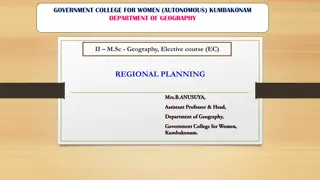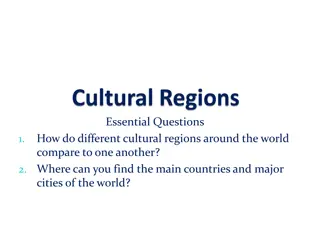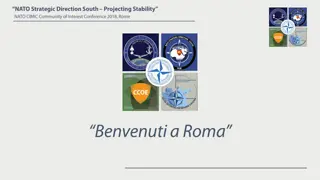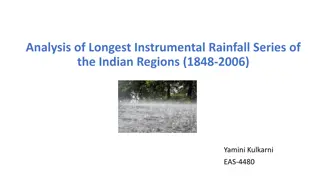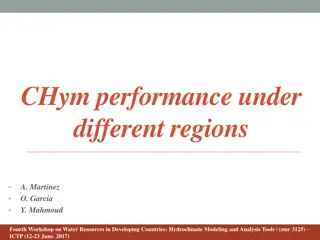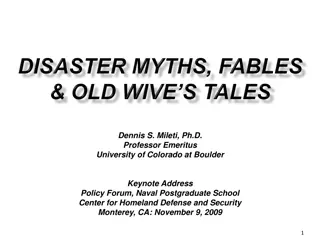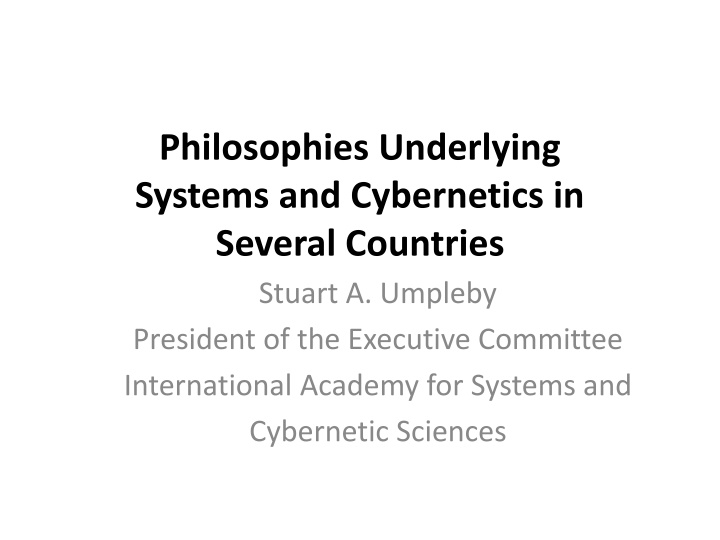
Exploring Philosophies and Systems in Cybernetics Across Regions
Delve into the world of cybernetics as Stuart A. Umpleby discusses the philosophies, systems, and developments in this field across different countries. Learn about the mission of the International Academy for Systems and Cybernetic Sciences, the evolution of cybernetics in Europe, North America, Russia, and China, and the unique values that set this field apart from traditional disciplines. Discover how cybernetics integrates knowledge from various fields, aims for unification of science, and seeks to create more general theories to enhance interdisciplinary communication.
Download Presentation

Please find below an Image/Link to download the presentation.
The content on the website is provided AS IS for your information and personal use only. It may not be sold, licensed, or shared on other websites without obtaining consent from the author. If you encounter any issues during the download, it is possible that the publisher has removed the file from their server.
You are allowed to download the files provided on this website for personal or commercial use, subject to the condition that they are used lawfully. All files are the property of their respective owners.
The content on the website is provided AS IS for your information and personal use only. It may not be sold, licensed, or shared on other websites without obtaining consent from the author.
E N D
Presentation Transcript
Philosophies Underlying Systems and Cybernetics in Several Countries Stuart A. Umpleby President of the Executive Committee International Academy for Systems and Cybernetic Sciences
My background I attended conferences in Vienna and Amsterdam Also, Namur, RC51, ISSS, WOSC My education was at UIUC with Ashby, von Foerster, Maturana, Varela, Beer, Pask, Lofgren I have worked with the Am. Society for Cybernetics, attempting to bring about a scientific revolution in cybernetics and recently in science itself
The Mission of the Academy Acknowledge and honor the work of outstanding contributors to the field Improve and strengthen the field through education, research and practice Academicians contribute to encyclopedias, handbooks, websites, on-line discussion groups, and educational programs
I have sought to find out what is happening in the field What questions are being asked? What theories are being used? What philosophies are present or absent? What are the main agreements and disagreements in the field? I found there are three stages in the development of cybernetics in three regions of the world Europe and N. Am., Russia and China
Our field is different from traditional fields We work on several levels -- philosophy, theory, and practice We seek to integrate knowledge in the traditional fields and in our own fields We strive for the unification of science We use ideas from one field to enrich thinking in other fields (e.g., Warren McCulloch used knowledge from neurophysiology to resolve debates over epistemology)
Some values in our field The traditional disciplines focus primarily on testing theories and applying theories in practice We strive to create more general theories, more fundamental concepts We seek to aid communication among disciplines
Second order cybernetics Two parts of cybernetics theory and technology Since the 1970s theoretical work in cybernetics has advanced under the name second order cybernetics An effort to shift attention from engineering applications to the biology of cognition Von Foerster s students and friends began an effort to make a scientific revolution in cybernetics by promoting the idea of second order cybernetics
Including the observer Based on his experiences with the Macy conferences in the late 1940s and early 1950s Heinz von Foerster wanted to include the observer within the domain of science This was a major departure from the prevailing view that the observer needed to be excluded from consideration in order to create objective descriptions
Beginning a scientific revolution By the mid 1970s several neurophysiological experiments had shown that the brain does work for us that we are not aware of Because brains are different due to training and experiences, the possibility of excluding the characteristics of the observer from observations was thought to be not possible
First and second order cybernetics in the 1970s Observing systems The purpose of the modeler Autonomous sys. Interaction between observer and observed Theories of the interaction between ideas and society Observed systems The purpose of a model Controlled systems Interaction among variables in a system Theories of social systems
The work of the Biological Computer Laboratory For several years this group described first and second order cybernetics at conferences in the US and Europe After a while the group wanted to move on to a new period of normal science They began to ask how they would know that the revolution had succeeded They decided to use the Correspondence Principle
The cybernetics of science NORMAL SCIENCE The correspondence Incommensurable principle definitions SCIENTIFIC REVOLUTION
The Correspondence Principle Proposed by Niels Bohr when developing the quantum theory Any new theory should reduce to the old theory to which it corresponds for those cases in which the old theory is known to hold A new dimension or idea is required
New philosophy of science Old philosophy of science Amount of attention paid to the observer An Application of the Correspondence Principle
Advantages of using the Correspondence Principle The new dimension either was neglected or was assumed not to be significant All the data that supported the old theory also supports the new theory (small circle) Now many more experiments can be conducted to investigate the region created by the new dimension (large oval)
Additions to the conception of science We have used the Correspondence Principle to define three ways that we think science should be expanded 1. Amount of attention paid to the observer 2. Amount of interaction between ideas and society 3. Methods to create new hypotheses
The importance of second order science Expanding our conception of science opens new lines of investigation for research Treating physics not as an example for all of science but rather as a special case of a larger conception of science will help the unification of the sciences The earlier conception of science was created to deal with inanimate objects Thinking participants are significantly different New possibilities for research are also created when we include the subjects of social research in the group of experimenters
Three theories of knowledge World Pragmatism Positivism Description Observer Constructivism
Three epistemologies The realist approach to science would be the left side of the triangle Second order cybernetics would be first a theory of knowledge (bottom) and later also a description of how knowledge is used (right side) To avoid an infinite regress (third, fourth, fifth) American cyberneticians stopped with reflexivity With the triangle second order cybernetics became not a competing epistemology to realism but a theory of epistemologies
Engineering Cybernetics Biological Cybernetics Social Cybernetics The view of epistemology A realist view of epistemology: knowledge is a picture of reality A biological view of epistemology: how the brain functions A pragmatic view of epistemology: knowledge is constructed to achieve human purposes A key distinction Reality vs. scientific theories Realism vs. Constructivism The biology of cognition vs. the observer as a social participant The puzzle to be solved Construct theories which explain observed phenomena Include the observer within the domain of science Explain the relationship between the natural and the social sciences What must be explained How the world works How an individual constructs a reality How people create, maintain, and change social systems through language and ideas A key assumption Natural processes can be explained by scientific theories Ideas about knowledge should be rooted in neurophysiology. Ideas are accepted if they serve the observer s purposes as a social participant An important consequence Scientific knowledge can be used to modify natural processes to benefit people If people accept constructivism, they will be more tolerant By transforming conceptual systems (through persuasion, not coercion), we can change society Three Versions of Cybernetics
Features of second order science Second order science adds additional dimensions to our conception of science thereby expanding the region susceptible to scientific investigations It offers ideas that contribute to quality control in science Includes subjects in the class of experimenters, and hence provides a way of investigating purposeful systems
Consequences of the philosophical differences In my experience Europeans approach problems with a larger set of conceptual possibilities than do Americans The philosophy of realism works well for the natural sciences but not as well for the social sciences Wiener s second industrial revolution, concerned with control and communication, requires a different philosophical foundation than the first industrial revolution, which was concerned with matter and energy
Cybernetics in Russia Vladimir Lefebvre s theory of reflexive control has had many applications in Russia in strategic thinking, in education, and in psychotherapy In the U.S. his theory of two systems of ethical cognition was a key to ending the Cold War Dmitry Novikov s recent book on cybernetics cites many authors that I have not heard of previously Vladimir Lepskiy and his colleagues at the Institute of Philosophy of the Russian Academy of Sciences (RAS) are developing the idea of third order cybernetics
PHILOSOPHICAL LEVEL METHODOLOGICAL LEVEL THEORETICAL LEVEL Type of scientific rationality Philosophical approach Paradigms or models Scientific approach Areas of knowledge Classical Positivism Subject - Object Activity approach Cybernetics Monodisciplinary approach Non - classical Philosophical constructivism Subject - Subject Subject-activity approach Second order cybernetics Interdisciplinary approach Post - non - classical Humanistic Subject - Meta-Subject Subject-focused approach Third order cybernetics (post-non-classical cybernetics of self- developing reflexive- active environments) interpretation of philosophical constructivism Self-developing reflexive-active environments Transdisciplinary approach
Third order cybernetics in Russia In Russia first order cybernetics refers to what is observed Second order cybernetics refers to the observer and methods and techniques of observation, but there is no mention of the biology of cognition Third order cybernetics focuses on social concerns, particularly the meta system at any level The philosophers referred to are recent or contemporary Russian philosophers Aleksej Leontiev, Sergei Rubinshteyn, George Shchedrovitsky, Vyacheslav Stepin, Vladimir Vernadsky, Lev Vygotsky
The meta subject refers to the social context The micro level individuals, families, and work teams The meso level organizations and cities The macro level nations, the world Theorists in both traditional disciplines and systems and cybernetics have written about the micro and meso levels But at the macro level Russian theorists focus on recent Russian authors
The Macro level My interpretation is that for the key authors at the macro level one must go farther back in time In the 17th century people were trying to figure out how to create self-governing societies The task was to build a reflexive society, one in which people were both rulers and ruled Eventually the goal became to go beyond both the king and the Pope (both still exist but have diminished power)
Society as a reflexive system The macro level is the most reflexive level There are many feedback loops in a large social system There are many challenges how to resolve internal conflicts, how to defend the society against interference from outside, how to create an innovative society and how to achieve steady social progress
Leading theorists were Thomas Hobbes (1588 1679) England John Locke (1632-1704) England Voltaire (1694 1778) France Jean-Jacques Rousseau (1712 1778) France Edmund Burke (1729 1797) Ireland
Two goals of self-government Acemoglu and Robinson in their book Why Nations Fail suggest that nations must learn how to do two things Assemble enough power to achieve social purposes Limit the power of the executive so that the rights of individuals are not compromised
Organizational structures A federal system local, state and national governments Branches of government legislative, executive, and judicial branches The branches were independent and could check abuse of power by another branch Other institutions free press, business organizations, labor unions, public education, non-governmental organizations
Principles of government Majority rule and minority rights Right to private property Limits on the power of government, trial by jury, right to a lawyer Religious liberty Freedom of speech Secular authority replaced religious authority The state -- the citizenry as a whole -- could regulate both religion and the economy
A common point of view During the Cold War there were two points of view capitalism and communism These ideologies gave meaning and purpose to life and provided organizing principles An alternative, more general point of view is what Karl Popper called piecemeal social engineering and what Donald T. Campbell called an experimenting society
Third order cybernetics If third order cybernetics is seen as a theory of experimentation and reform in social systems, it will connect the earlier work in cybernetics with political reform and the evolution of society This is a major addition to cybernetics and to the unification of science
SYSTEMS AND CYBERNETICS IN CHINA (Based on a presentation by Jifa Gu)
Philosophy, theory and practice in China China is a very old civilization with a different philosophy than has been developed in the West China has made tremendous progress in recent decades in lifting millions of people out of poverty About as much concrete has been poured in China in the 21st century as the US poured in the 20th century. Not only has China constructed many buildings, roads and bridges, it has also educated the managers of these projects
Systems engineering in China The Wuli-Shili-Renli (WSR) Approach also has three parts Wu objective existence Shi -- subjective modeling Ren human relations These three constitute a differentiated whole The method has been developed within the Oriental context influenced by its philosophical, cultural, sociopolitical and economic features
A philosophy of harmony in China Chinese philosophy has been characterized by its belief in harmony and holism The three major ancient Chinese philosophical traditions (Taoism, Buddhism, and Confucianism) all emphasize harmony Opposites are seen as being parts of a whole Unity of Yin (negative, lunar, feminine) and Yang (positive, solar, masculine) Unity of Zhi (knowing) and Xing (doing)
Differences between East and West The Chinese focus primarily on social relationships (in families, organizations, and societies) Western thinking focuses more on relations between humankind and the material world, on the world and our descriptions of the world Oriental culture at the very start of a project is concerned with moral considerations As a result the East extends greater respect to the common good and/ or group benefit
Systems engineering in China In the 1970s and 1980s Chinese scholars used system engineering methods from the West (e.g., A.D. Hall III) Several case studies were done Regional development Global climate change Evaluation problems Water resources management These early studies emphasized Wuli (machines, substance) and Shili (analytic methods, simulations) In 1990s Renli was added by Gu and Zhu to create a systems approach
A problem with early methods A survey showed that the results of the early studies were not acknowledged by leaders in Beijing Mid level and top level opinions were different They realized they had to understand the desires of leaders first, then try to communicate with them
A belief that Ideas are developed through action Chinese believe that human beings understand and create the world simultaneously Human conceptions, intentions, and actions cannot be properly investigated if separated from their surroundings or from one another Morality, knowledge, and action of human beings are mutually supportive and cannot be artificially isolated from one another
Interests vs. theoretical issues In the US the three stages engineering cybernetics, biological cybernetics and social cybernetics are areas of interest influenced largely by the interests of the people who were active in ASC at the time In Russia the three stages can be traced to changes in philosophical interests In China the three phases resulted from interpretations of practical work
Conclusions about the 3 regions US and EU are not as similar as they think There is a major difference in epistemologies realism in the US and constructivism in Europe Scholars in the US are less familiar with the work of European philosophers Combining American pragmatism with European interest in theories and philosophies leads to a large number of conceptual possibilities Wiener s second industrial revolution requires a philosophical background which is different from that of the first industrial revolution
Philosophy or mathematics Several systems theories are more interested in mathematics than philosophy. Operations research, system dynamics, artificial intelligence and complexity all place a high value on inventing and using mathematical methods These branches of systems and cybernetics have been less interested in theories and philosophies




